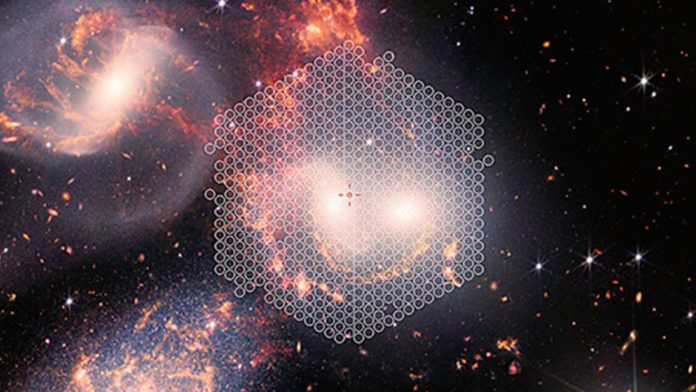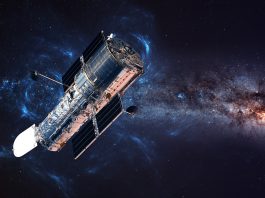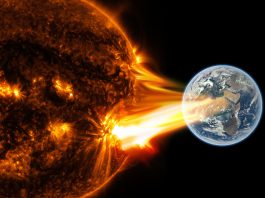More than 500 astronomers across Europe have designed and planned five years of operations for the WEAVE spectrograph, a powerful instrument recently installed at a Canary Islands observatory.
Combined with the Gaia Telescope’s measurements, studying a wide range of stellar and galactic science cases is possible. The first observations show distinctive aspects of the collision between the galaxies at the heart of Stephan’s Quintet, 280 million light-years from Earth.
Details of the study were published in arXiv.
What will the spectrograph measure?
Roberto Raddi, from UPC, said: “Our team will contribute to the study of some 100,000 white dwarfs previously observed by Gaia and discover the secrets behind the last evolutionary stages of Sun-like stars, including the fate of their planetary systems and the mechanisms leading to supernova explosions in binary systems with white dwarfs.”
Astronomers from all over Europe have planned eight surveys for observation with the WEAVE spectrograph, including studies of stellar evolution, the Milky Way, galaxy evolution, and cosmology.
Together with the European Space Agency’s Gaia satellite, WEAVE will be used to obtain spectra of several million stars in the disk and halo of our galaxy, the archaeology of the Milky Way.
Nearby and distant galaxies will be studied to learn how they grew, and quasars will be used as beacons to map the spatial distribution and interaction of gas and galaxies when the Universe was only about 20% of today’s age.
Maria Monguió, from the ICCUB-IEEC, commented: “After years of preparation, we hope to be able to obtain the first spectra of stars in the disk of our galaxy. The quantity and quality of the millions of ranges that we expect to observe will allow us, among other things, to analyse regions of recent star formation and to measure how stars move.
“This data, together with those provided by the Gaia mission, will allow us to address fundamental questions about the formation and evolution of the Milky Way.”
Recording first-light observations
The WEAVE spectrograph targeted NGC 7318a and NGC 7318b, two galaxies at the centre of Stephan’s Quintet. Its galaxies, four of which are 280 million light-years from Earth, are colliding with each other, providing an excellent close-up laboratory to study the consequences of galaxy collisions and their subsequent evolution.
The first-light observations were carried out with the so-called Large Integral Field Unit (LIFU) fibre array, one of the spectrograph’s three fibre systems. When using the LIFU, 547 compact optical fibres transmit light from a hexagonal sky area to the spectrograph, where it is analysed and recorded.
WEAVE’s LIFU has measured a large number of individual spectra of the two central galaxies of Stephan’s Quintet and their surroundings, examining the intensity of the colours of their light, from the ultraviolet to the near-infrared. Among other information, these spectra reveal essential details to study collision processes, such as the motion and distribution of stars and gas and their chemical composition. From this data, we can learn how galaxy collisions transform the other galaxies in the group.
ING director Marc Balcells explained that the goal is “to install a unique instrument that will allow us to carry out cutting-edge astronomical research. It has been fantastic to receive financial support from the national research agencies of the three ING partner countries and contributions from other non-ING countries.
“We are pleased to demonstrate that the spectrograph works and produces high-quality data. The ING telescopes will continue to deliver results of high scientific impact in the coming years. We look forward to announcing soon the first-light events for the other observing modes, which are currently in the final calibration stage.”
Next-generation technology
The WEAVE spectrograph uses optical fibres to collect light from celestial objects and transmits it to a spectrograph that separates the light according to its different wavelengths. It can work at two different spectral resolutions, which are used to measure the speeds of objects in the line of sight (using the Doppler effect) and to determine their chemical composition. The versatility of WEAVE is one of its main strengths.
While the LIFU mode contains hundreds of fibres in a compact distribution, essential for extended imaging areas of the sky, in the MOS mode, about a thousand individual fibres can be placed (by two robots) to collect light from stars, galaxies or quasars simultaneously. During the first five years of operation, spectra of millions of individual stars and galaxies are to be obtained, a goal that can be achieved thanks to the spectrograph’s ability to observe so many bodies at once.









